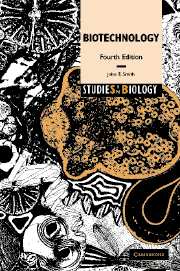Book contents
- Frontmatter
- Contents
- Preface
- 1 The nature of biotechnology
- 2 Substrates for biotechnology
- 3 Genetics and biotechnology
- 4 Bioprocess/fermentation technology
- 5 Enzyme technology
- 6 Biological fuel generation
- 7 Single cell protein (SCP)
- 8 Biotechnology and medicine
- 9 Environmental biotechnology
- 10 Biotechnology in the agricultural and forestry industries
- 11 Food and beverage biotechnology
- 12 Protection of biotechnological inventions
- 13 Safety in biotechnology
- 14 Public perception of biotechnology: genetic engineering – safety, social, moral and ethical considerations
- 15 Looking to the future
- Glossary
- Further reading
- Index
3 - Genetics and biotechnology
Published online by Cambridge University Press: 05 June 2012
- Frontmatter
- Contents
- Preface
- 1 The nature of biotechnology
- 2 Substrates for biotechnology
- 3 Genetics and biotechnology
- 4 Bioprocess/fermentation technology
- 5 Enzyme technology
- 6 Biological fuel generation
- 7 Single cell protein (SCP)
- 8 Biotechnology and medicine
- 9 Environmental biotechnology
- 10 Biotechnology in the agricultural and forestry industries
- 11 Food and beverage biotechnology
- 12 Protection of biotechnological inventions
- 13 Safety in biotechnology
- 14 Public perception of biotechnology: genetic engineering – safety, social, moral and ethical considerations
- 15 Looking to the future
- Glossary
- Further reading
- Index
Summary
Introduction
In essence, all properties of organisms depend on the sum of their genes. There are two broad categories of genes: structural and regulatory. Structural genes encode for amino acid sequences of proteins which, as enzymes, determine the biochemical capabilities of the organism by catalysing particular synthetic or catabolic reactions or, alternatively, play more static roles as components of cellular structures. In contrast, the regulatory genes control the expression of the structural genes by determining the rate of production of their protein products in response to intra- or extracellular signals. The derivation of these principles has been achieved using well-known genetic techniques which will not be considered further here.
The seminal studies of Watson and Crick and others in the early 1950s led to the construction of the double-helix model depicting the molecular structure of DNA and subsequent hypotheses on its implications for the understanding of gene replication. Since then there has been a spectacular unravelling of the complex interactions required to express the coded chemical information of the DNA molecule into cellular and organismal expression. Changes in the DNA molecule making up the genetic complement of an organism is the means by which organisms evolve and adapt themselves to new environments.
- Type
- Chapter
- Information
- Biotechnology , pp. 33 - 51Publisher: Cambridge University PressPrint publication year: 2004

